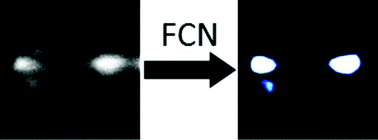Fully convolutional neural network for removing background in noisy images of uranium bearing particles
Abstract
A fully convolutional neural network (FCN) was developed to supersede automatic or manual thresholding algorithms used for tabulating SIMS particle search data. The FCN was designed to perform a binary classification of pixels in each image belonging to a particle or not, thereby effectively removing background signal without manually or automatically determining an intensity threshold. Using 8000 images from 28 different particle screening analyses, the FCN was trained to accurately predict pixels belonging to a particle with near 99% accuracy. Background eliminated images were then segmented using a watershed technique in order to determine isotopic ratios of identified particles. A comparison of the isotopic distributions of an independent data set segmented using the neural network with a commercially available automated particle measurement (APM) program developed by CAMECA was performed. This comparison highlighted the necessity for effective background removal to ensure that resulting particle identification is not only accurate, but preserves valuable signal that could be lost due to improper segmentation. The FCN approach improves the robustness of current state-of-the-art particle searching algorithms by reducing user input biases, resulting in an improved absolute signal per particle and decreased uncertainty of the determined isotope ratios.



 Please wait while we load your content...
Please wait while we load your content...